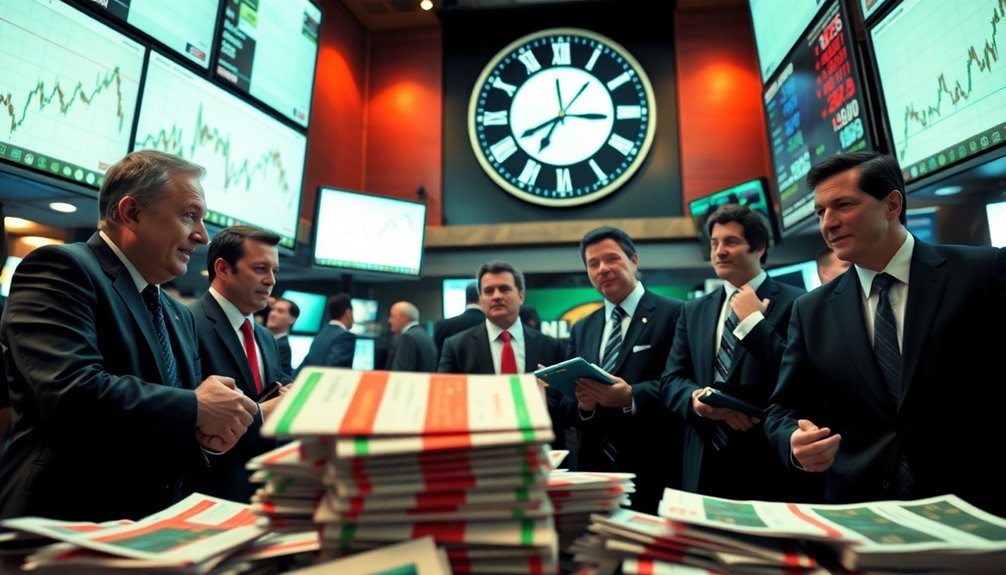Volatility means the degree of price fluctuations in investments over time. It shows how often and how much prices change, indicating both risk and opportunity. High volatility suggests a greater risk of loss but also the potential for larger gains. Low volatility, on the other hand, indicates more stability and less risk. Factors like supply and demand, economic conditions, and even geopolitical events can influence volatility. Understanding this concept is key to making informed investment decisions. If you keep exploring, you'll uncover more insights on how volatility affects your investment strategy and market behavior.
Key Takeaways
- Volatility measures the frequency and magnitude of price fluctuations in investments over time, indicating market risk levels.
- High volatility suggests greater risk and potential for loss, while low volatility indicates stability and lower risk.
- Price fluctuations occur due to supply and demand imbalances, influenced by economic conditions, corporate performance, and external factors.
- Volatility impacts investor behavior and market sentiment, often correlating with economic downturns and increased market uncertainty.
- Understanding volatility is essential for developing informed trading strategies and managing investment risks effectively.
Market Price Fluctuations Explained

When you look at market price fluctuations, it's clear that they stem from a variety of factors that interact in complex ways.
Supply and demand dynamics play a crucial role; prices rise when demand exceeds supply and fall when the opposite occurs. Temporary imbalances can lead to rapid price changes. Additionally, economic conditions like inflation and interest rates also influence prices, alongside government policies and external factors such as natural disasters or geopolitical tensions.
Corporate performance matters too—earnings reports, mergers, and financial health can sway investor confidence. Lastly, your behavior as an investor and overall market sentiment significantly impact trends, making timely analysis essential for navigating these fluctuations effectively.
Defining Market Price Volatility

Understanding market price fluctuations naturally leads to the concept of market volatility.
Market volatility describes how much and how often prices change in the stock market. It's a statistical measure of an asset's deviations from its average performance, indicating the severity of price swings.
When you look at volatility, you're assessing both the rate and size of price changes, which helps you gauge risk and anticipate future movements. Factors like supply and demand uncertainties, seasonality, and market speculation drive volatility. The root cause of volatility stems from investor uncertainty regarding asset pricing, which can be influenced by various external factors.
You can measure it using standard deviation or beta, and tools like the CBOE Volatility Index (VIX) provide insights into overall market risk.
Essentially, volatility reflects the potential for significant gains or losses in your investments.
Price Changes Over Time

As you track price changes over time, it's essential to recognize how volatility can shape your investment decisions.
Historical volatility, measured by the standard deviation of price swings, provides insight into past price behavior, helping you gauge stability or risk. When you notice increasing volatility, it often indicates larger price swings ahead, while low volatility suggests a more stable market.
Keep in mind that volatility isn't constant; it varies over time and can be influenced by factors like market microstructure or seasonal patterns. Understanding these dynamics allows you to anticipate potential price movements and make informed choices in your trading strategy, whether you're navigating crashes, bubbles, or everyday fluctuations.
Pros and Cons

Volatility can be a double-edged sword in trading, presenting both opportunities and challenges.
On the one hand, larger price swings create significant potential for gains. You can capitalize on rapid fluctuations and make multiple trades, increasing profits. Volatile markets offer various trading opportunities and enhance liquidity, making it easier to enter and exit positions. Additionally, increased volatility often leads to larger price swings, which can be advantageous for directional trading strategies.
However, increased risk comes with these rewards. Unpredictable price movements can lead to substantial losses if not managed properly. The emotional stress of rapid changes can challenge your discipline and decision-making. Plus, trading costs may rise due to wider spreads and higher slippage.
Balancing these pros and cons is essential for navigating volatile markets effectively.
Volatility vs. Stability

While navigating the financial markets, you'll often encounter the contrast between volatility and stability, each representing different investment landscapes.
Volatility indicates the level of risk associated with price changes. High volatility means your investments could swing dramatically, offering potential for greater profits but also higher risks. Conversely, stability suggests steadiness in prices, appealing to risk-averse investors who prefer consistent returns. In fact, historical events such as the Great Depression and the 2008 Financial Crisis illustrate the extremes of market volatility and its impact on investor sentiment.
When trading, you'll find that volatility suits short-term strategies, while stability aligns with long-term investments.
Volatility indicators like the VIX help identify trading opportunities, while stable investments often rely on fundamental analysis.
Ultimately, understanding the balance between these two can guide your investment choices based on your risk tolerance and financial goals.
Market Sentiment Shifts

Understanding how volatility and stability affect your investments sets the stage for recognizing market sentiment shifts. Economic events, like changes in interest rates or employment rates, can quickly alter investor attitudes. In today's landscape, the growing focus on ESG considerations also influences investor sentiment and market dynamics.
When central banks announce new policies, you might notice immediate reactions in market mood. Media coverage also plays a crucial role; positive or negative news can drive rapid sentiment changes. It's essential to consider that high VIX levels can indicate potential market bottom signals, reflecting investor fear and uncertainty.
Remember, rumors can sway opinions, regardless of their accuracy. Additionally, emotional factors, such as fear and overconfidence, often distort how you perceive market conditions.
Utilizing technical indicators like sentiment analysis and put-call ratios can help you gauge market sentiment effectively. By staying attuned to these shifts, you can make more informed decisions about your investments.
Recent Market Volatility Patterns

As you navigate the financial landscape, recent market volatility patterns can significantly impact your investment strategy.
Historical volatility measures price variability over various time frames, indicating risk levels associated with specific assets. When you notice an increase in historical volatility, it signals that prices are deviating from their averages, suggesting heightened risk. Conversely, a decrease points to more stable price movements. Understanding volatility dynamics can further assist you in making informed decisions during turbulent times.
Implied volatility, assessed through instruments like the VIX, estimates future market fluctuations and reflects investor sentiment. Economic uncertainties, political instability, and global events can amplify volatility, affecting your decisions.
Diversify Your Investment Portfolio

To build a robust investment portfolio, diversifying your assets is essential for managing risk and enhancing returns. By spreading your investments across various asset classes—like stocks, bonds, and cash equivalents—you reduce the impact of any single investment's poor performance. This strategy not only minimizes volatility but also stabilizes your portfolio's overall performance. Additionally, utilizing state-specific benefits can enhance your retirement savings potential when planning for the future.
Consider sector diversification as well; investing in different sectors, such as technology and healthcare, protects you from losses in any one area. Additionally, combining equities with bonds can help further stabilize your portfolio value.
Utilizing investment vehicles like mutual funds, ETFs, and REITs can simplify this process, giving you broader exposure. Don't forget about global investments and holding some cash for extra safety. Ultimately, a well-diversified portfolio is key to achieving long-term financial success.
Frequently Asked Questions
How Is Volatility Measured in Financial Markets?
In financial markets, you measure volatility using several tools.
Standard deviation shows how much an asset's returns deviate from its average.
Beta compares an asset's volatility to the market, indicating risk levels.
Maximum drawdown reveals the worst drop from a peak, helping you assess potential losses.
Lastly, the VIX provides insights into expected market fluctuations over the next 30 days, often reflecting investor sentiment and uncertainty.
What Causes Sudden Spikes in Market Volatility?
Sudden spikes in market volatility can catch you off guard. They often arise from geopolitical tensions, unexpected economic data releases, or major corporate announcements.
When elections or conflicts occur, uncertainty drives rapid market changes. Additionally, central bank decisions, like interest rate adjustments, can shake investor confidence.
You might notice that even a single scandal can send stocks tumbling, illustrating how interconnected factors can lead to unpredictable market behavior.
Can Volatility Indicate Market Opportunities?
Absolutely, volatility can signal market opportunities.
When prices fluctuate significantly, it often means you can buy stocks at lower prices during downturns, anticipating future rebounds.
You might also explore options trading, where changes in volatility can enhance profit potential.
By strategically positioning yourself during volatile periods, you can capitalize on price changes and find hidden gems that others might overlook.
Embracing these fluctuations can lead to rewarding investment strategies.
How Does Volatility Affect Long-Term Investments?
Volatility significantly affects your long-term investments by influencing your decision-making.
When the market swings wildly, you might panic and sell, locking in losses instead of holding for potential gains.
Higher volatility can lead to greater short-term gains but often results in lower long-term returns due to compounding effects.
Sticking with a low-volatility portfolio might provide you with steadier growth and help you achieve your financial goals more reliably over time.
Are There Different Types of Volatility in Finance?
Imagine a rollercoaster ride, where the ups and downs represent different types of volatility in finance.
You've got historical volatility, which looks back at past price movements, and implied volatility, reflecting market expectations for the future.
Then there's price volatility, showing daily fluctuations, and market volatility, capturing the broader market's mood.
Each type serves a purpose, helping you navigate investments and understand risks in this ever-changing financial landscape.
Conclusion
In a world where price swings are as common as coffee breaks, understanding volatility is like trying to tame a wild beast. Sure, riding the rollercoaster of market fluctuations can be thrilling, but it's not for the faint-hearted. Embrace the chaos or stick to your safe, snooze-worthy savings account. Just remember, whether you're dancing with volatility or hugging stability, the market's got a sense of humor, and it's always ready to throw you a curveball!









